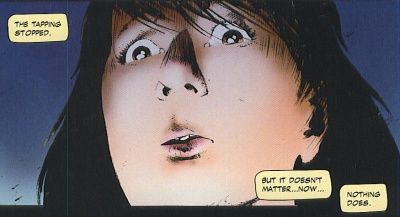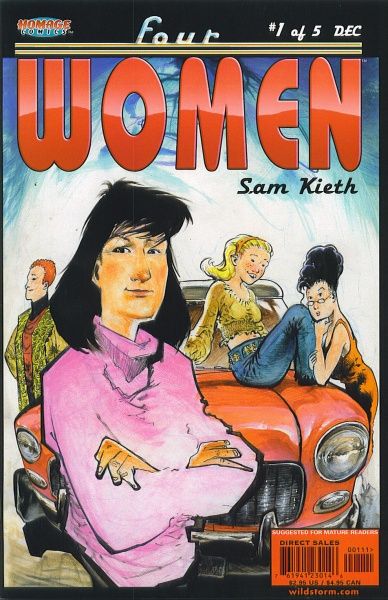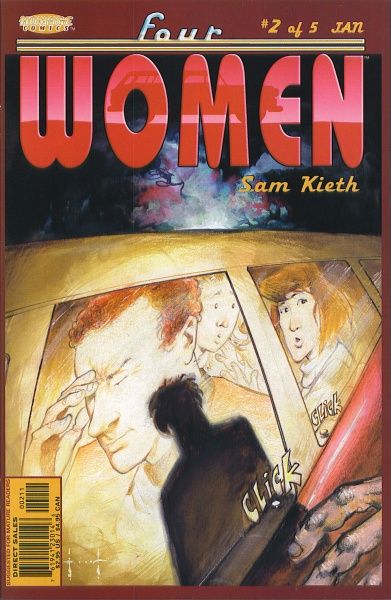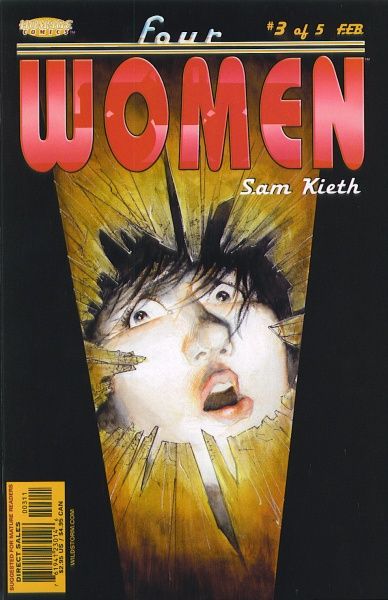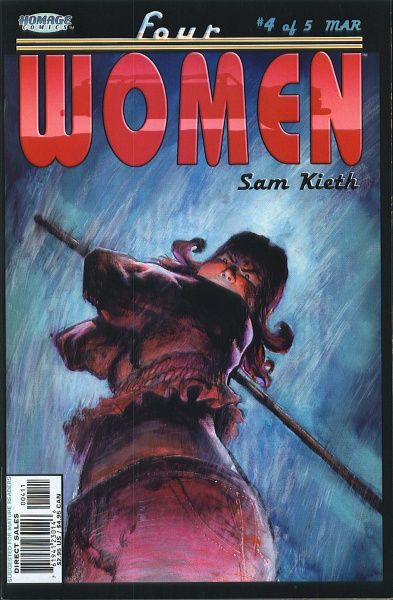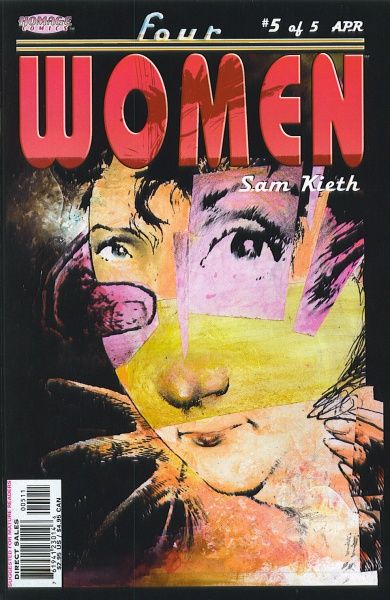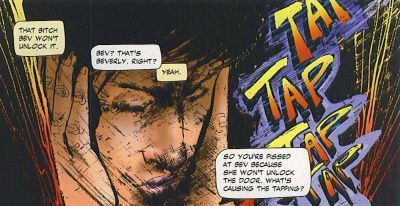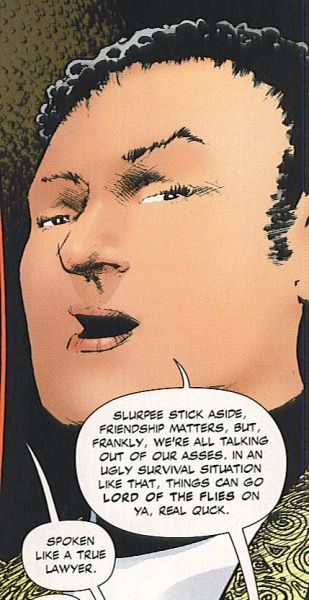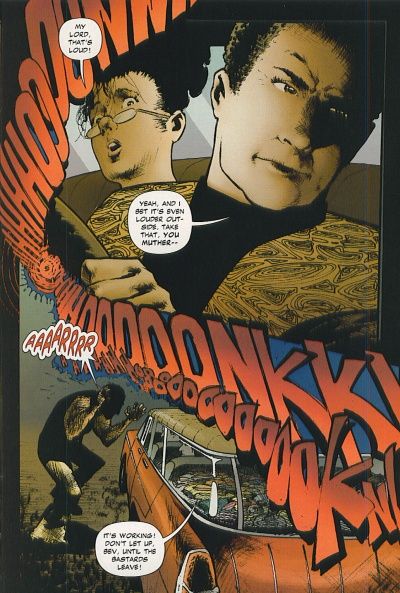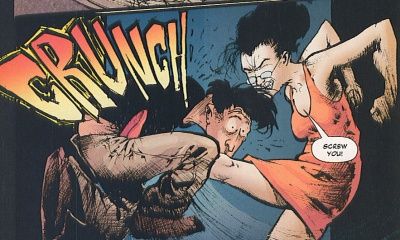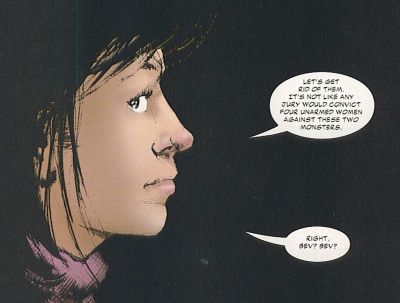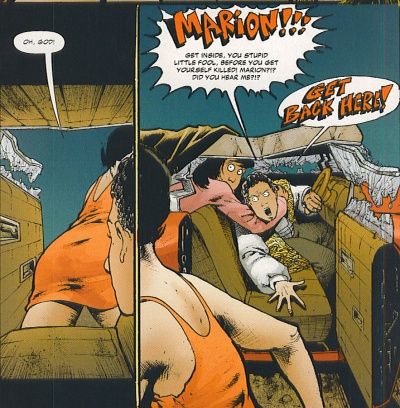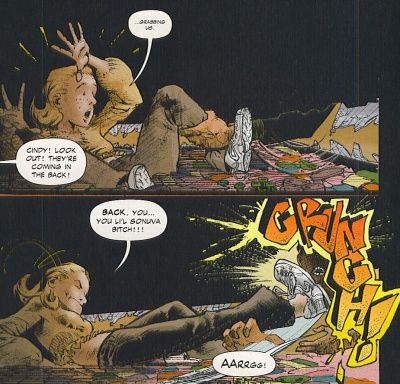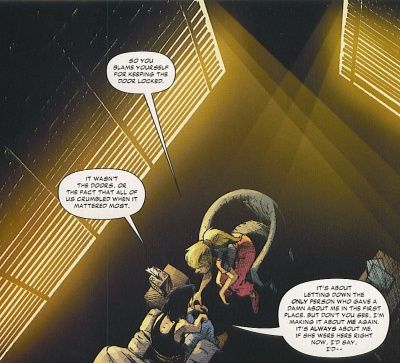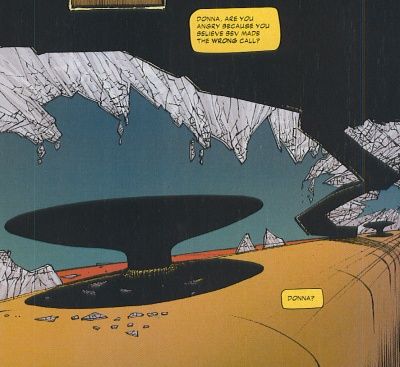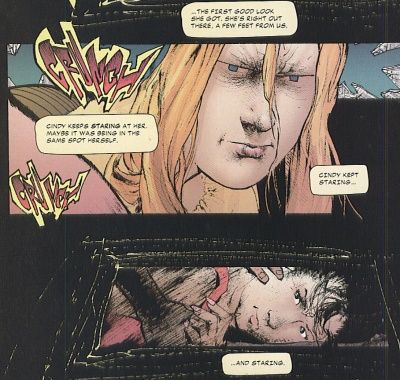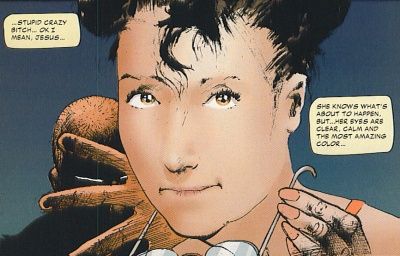If you've ever wondered if Sam Kieth is awesome, well, the answer is: Yes, yes he is. And yes, there are SPOILERS in this post!
Four Women by Sam Kieth (writerand artist), with additional inks on issue #1 by Jim Sinclair.
DC/Wildstorm/Homage Comics, 5 issues (#1-5), cover dated December 2001-April 2002.
We begin with a tapping. Someone is knocking on a car door, and someone else won't let her in. Suddenly the woman outside is dragged away, and the tapping stops. But it continues to resonate throughout the entire series. Why is she tapping? Why won't they let her in? What happens to her? And so starts Sam Kieth's terrifying but inspiringmini-series, Four Women, the latest Comic You Should Own.
In a mainstream comic book world that often indulges in stereotypes, mostly on the feminine side, Kieth gives us four women who confound stereotypes. They act like people, with sudden heroism contrasted withugly cowardice, gallows humor mixed with silent pleading. They are, in essence, real. They don't always tell the truth, or act nobly, but they do the best they can. It's this characterization that makes the story so horrifying. It's the story of a rape, but it's more the story of how these women choose to deal with the situation in which the rape occurs and how they deal with the aftermath that makes this such a chilling comic.
Kieth tells the story almost entirely in flashback, with his narrator, Donna, telling her therapist about the events of the evening. This allows Kieth to do a coupleof things that help create the story and the mood:He begins the story in the middle, at the very moment when the rape becomes a reality, which is themost tense moment in the tale. This meanswe don't know how the women got there nor what happened afterward, and Kieth goes back and forth through time to get usto the resolution. The other thing he can do with a flashback is establish Donna as the narrator, and as the story unfolds, it becomes clear that she's unreliable, and it forces us to reassess how we view the early issues and Donna herself. We are used to believing the narrator of a story, even though over the years unreliable narrators have come more and more into vogue, so that when we realize Donna has been lying, it's a punch in the gut. Kieth does foreshadow her betrayal, but it's still a nice use of both the narrator and the flashback.
The way the story is set up means that we get into the conflict of the series right away. Marion, the woman outside the car, is trying to get in. Donna is listening to her tap, and she tells the therapist, "It's a power lock. Bev won't let me." When the therapist asks why Bev locked Marion out, Donna replies, "'Cause she's a bitch. A stone-hearted bitch that only cares about herself." The therapist asks about Donna's anger toward Bev, and why it's so vitriolic. It's a crucial plot point, and we'll get back to it.
With that beginning firmly in our heads, Kieth backs up and introduces the characters. He does a nice job establishing them in a few short pages, and also gives us plenty of foreshadowing. Donna is still narrating, and we find out that Bev is a lesbian lawyer who is "the realist" of the group; Donna herself is a divorced teacher with two kids; Marion is a mother of four and a Christian Republican whose husband dumped her for a younger woman; Cindy is 19 and plays the dumb blonde role, although, Donna tells us, "there's more to her than meets the eye." The women engage in some nice banter, but even that is tinged with coming tension, as Cindy asks Marion, "Ever get caught with your pants down?" She's asking about something embarrassing, but as we already know, it becomes something more literal and more horrible, for both women, later. Then Marion brings up the "bomb shelter" game that she and Donna have played in the past - who do you let in a bomb shelter, your friends or people who are essential for building a new society. Bev, naturally, says that survival is most important of all, and that everyone in the car would do anything they had to in order to survive. Donna gets the final word: "Looking around at the faces in this car, I know ... some things are more important than survival." Kieth does a nice job of establishing that Bev would turn on her friends, while Donna considers them more important than that.
When the women reach a gas station, things start to get a bit weird. Nothing bad happens, but Donna insists that Bev take a break from driving. The keys fall to the ground, and Donna says "Bev picked 'em up." The therapist says, "So Bev's driving?" and Donna says, "Right." This turns out to be a crucial juncture in the story. We don't think much of it until later, because the bad guys soon show up.
Kieth again toys with the chronology, as the car breaks down on a lonely stretch of road and two guys in a jeep show up. Bev, in the driver's seat, locks the doors, and Donna, sitting in the back, pushes Cindy away from the window. On the next page, it's two hours later, and Bev is driving the car as fast as she can while Cindy comforts Marion in the seat next to her. We can surmise that Marion has already been raped, but we don't know how it happened. Cindy offers a clue about what happened: "I know I have no right to even say this ... But Donna wouldn't let her. Bev had no choice." We guess that Bev wanted to help and Donna stopped her. But we don't know why Donna had so much power and Bev didn't. Donna, meanwhile, is hunched on the floor in the back seat with her eyes closed. Kieth has again used the flashback format to build tension. Donna is telling this story, so she skips around, and we're still in the dark. Kieth eventually gets back to the guys strolling up to the car, but by then we know that something bad happened to Cindy, as well. Cindy is lying in the back of the station wagon, and the roof is crushing her. We don't know why the roof is indented, but Cindy is trapped. Donna is still angry at Bev, but the therapist convinces her to go back to when the men came up to the car. Kieth then gives us a simple narrative: the men try to get in, Bev locks the doors and honks on the horn, which drives them away temporarily, but then they get in their jeep and drive over the car, crushing the roof down. They break the windows and try to get in, and Cindy crawls into the back and kicks one of them in the mouth. He grabs her and drags her legs out of the car, then pulls her pants down. That's why she was stuck in the back and why Donna is so angry at Bev, because Cindy is about to get raped and Bev isn't doing anything. Marion realizes that the car is on a slight hill, so she releases the parking brake and the car rolls away. The men, however, put a brick in front of the tires and get back to Cindy.
Marion decides that she's had enough, disables the power locks, and gets out of the car. She throws a rock at the men, kicks one of them in the groin, and lures them away from Cindy. We're back at the beginning of the book, as Marion starts tapping on the window. The men drag her away, and as they rape her, Donna gets a car jack and ratchets up the roof, allowing Cindy to crawl inside. When one of the men notices, he also crawls inside, at which point Donna releases the jack and traps the man. Then, it's time for some bloody revenge.
This is where Donna's story starts to slip a bit. She and Cindy take turns bashing the guy with the jack, and Donna says Bev is pulling on her to stop. Bev says, "For God's sake, Bev!" and the therapist asks "Why'd she call you Bev?" We see that Donna is actually sitting in the driver's seat, while Bev is in the back. In that moment, we realize that Donna has been lying and that she was driving, she told everyone to stay in the car, and she refused to let Marion back in. Bev comforted Cindy, found the car jack, trapped the man, and beat on him. Donna doesn't want to talk about this yet, so we check outside, where Cindy has picked up a long piece of pipe and is exacting some revenge on the other guy, who ends up skewered on a different piece of pipe. The women have to decide what to do with two dead bodies. Her story continues to fall apart, as she says in response to a question about who's driving, "This time, Bev is." The bodies of the two men are in the back seat,a point that which Donna alsoneglected to mentionthe first time she related this part of the story. Bev drops them off at the hospital and dumps the bodies somewhere. There's an investigation, but it goes nowhere. And then we're past the night, and Donna is trying to reconnect with everyone. Cindy found God and teaches at a Sunday school, and Bev split with her partner and refuses to talk to Donna. Donna is most upset about the fracturing of her relationship with Marion, and her therapist says that she should just go and talk to her. Before she can do that, however, she has to tell the truth about what happened. Donna finally breaks down and admits that when Bev dropped the keys at the gas station, she (Donna) picked them up, and she was the driver when the car broke down and the guys showed up. We see everything again, but this time it's Donna who won't open the locks, and when Marion does get out, Donna won't let her back in. Bev eventually gets the jack and bashes the guy.
Why does Kieth tell the story this way? Well, that's easy to answer: Donna is telling the story, and she doesn't want to admit that she was weak when Marion was strong. Donna says, "Somebody had to be strong enough to keep them out. I thought that was me ... but it was Marion." She says this as we get a shot of Marion on the ground, enduring the rape in order to save Cindy. However, the story is more complex than this. The comic isn't really about Marion's rape and Cindy's near-rape. It's about what defines these women and how they deal with a situation that has no answer. As I've mentioned, Donna and her friends discuss what they would they do in this sort of situation, and Donna claims that she would put her friends above survival and Bev wouldn't. Throughout the issues dealing with the rape itself, we think less of Donna because she doesn't do what Marion does, that is, get out of the car and distract the men from raping Cindy, but we think even less of Bev, who locks the doors and stands firm. But we also believe that Bev and Donna are sticking to their principles, and when Cindy and Donna turn the tables on the one rapist, we're encouraged by Donna finally growing a spine. When we finally realize that Donna has been lying, she becomes even more culpable, as she not only fails to help (which, to be honest, isn't that difficult to believe) but she also betrays her stated principles. Marion never takes a stand when they talk about the "bomb shelter" situation while they're driving, but Cindy does make the point that Marion would be "the first to be picked off in some end-of-the-world scrap heap." Nobody in the car believes that Marion has any strength, because she's the good Christian, but that's what does give her the strength. She refuses to betray her own principles, and although she "pays" for it, she gives up her own safety to save Cindy.
Why does Donna lie? That's easy, too, andpart of what makes this comic so good. We can relate to Donna very easily. Kieth makes Donna such a sympathetic figure, and by making her sympathetic, he is able to indict both her and us as we read this.Many peoplewould take Donna's position, that friends are more important than survival, because it sounds nicer than Bev's position of bleak pragmatism. Many of us, however, have not been placed in a position where we have to take this kind of stand. Donna is placed in this situation, and she crumbles. Kieth does a wonderful job making Donna the kind of person that we like, so when she fails to save Cindy or Marion, we question what our position would be. Even before we know Donna is the one who won't open the car door, we are placed in this position. Would we be fiery like Cindy, who kicks one of the men in the mouth? Would we be stoic like Bev (but really Donna), who locks the doors and keeps them locked? Would we be heroic like Marion? Would we be encouraging like Donna (but really Bev) who tries to help Cindy through her ordeal before Marion makes a break for it. We're in an uncomfortable place, and then Kieth twists the story even more to make us even more uncomfortable. It's a masterful job.
Kieth even gives us an ending with a small twist. It ends with a reconciliation between Donna and Marion, but it's also ambiguous. Marion is supposed to forgive Donna, and she does to a certain extent, but it's a much more realistic exchange between friends than a simple "I forgive you because I love you." Donna cares more about self-flagellation than if her friends are okay, and Marion calls her on it. We realize that for Donna, it's really not about making sure her friends are okay and in the bomb shelter because she wants them to be okay. What she really wants is to have her friends with her because it makes her feel better. Marion says being a "selfish bitch" isn't a crime, and we understand that part of friendship is being selfish - Donna's desire for her friends is selfish, but natural. Why Marion is the hero of the book is because she can transcend the pettiness of everyday life and reach for something better. Donna isn't a bad guy, she's just a regular person. She doesn't stand up for her friends, but it's important for her friend to forgive her, because it will make her feel better. It's a nice complex issue, and Kieth does an excellent job exploring it.
For most people, Kieth is an artist before a writer, and Four Women looks truly amazing. From the first page, in which the door lock dominates the page from the lower right corner, while the incessant and abnormally-sized "Tap Tap Tap" runs downward toward it and into the darkness outside the car, we know we're seeing a masterpiece of design. Kieth begins with the four women, all of whom actually look like real people (Bev is a bit stereotypically lesbian, but at least she looks like a person), and continues as the story grows grimmer. His two men, who are poorly developed as characters (which is fine, as they are supposed to be grotesque monsters), are sinister and overlymasculine, and the fact that they rarely speak makes them even scarier. Kieth uses lettering to masterful effect, like when Bev (but really Donna) blows the horn to drive the men away. The honking sound effect fills the page, dominating the shadowedman, who crouches in pain from the noise. Two different letterers are creditedfor the series, but the sound effect lettering is such a part of the art design I have to believe Kieth did it himself. Kieth really shines as the men drive over the car with their jeep and crush the roof in and then cover the car with a tarp. He creates a claustrophobic atmosphere that is accentuated by the panel design, which crushes the women as surely as the roof does. When he does open the panels up a bit, he focuses back on the plastic door lock, which once again dominates the page. It's a disturbing image, but one made more disturbing by Kieth's skewing of perspective.
Kiethalso does a wonderful job at focusing on faces while some of the more disturbing action is taking place. For instance, when Donna (but really Bev) is killing one of the rapists with the car jack, Kieth shows Cindy staring out the window as Marion as the other man rapes her. We get Cindy's eyes narrowing as she gets angrier and angrier, Marion calmly enduring, and the sound effect "Crunch" repeated on the side of the page as Bev kills the man. Cindy busts out of the car and picks up the pipe, and the page where she strikes the man raping Marion is simply and red line with a bloody sound effect in the middle. It's horrifying yet beautiful at the same time.
One aspect of the art that is more astonishing than anything else is the way Kieth draws the faces of his protagonists, and especially their eyes. Cindy's eyes are innocent pinpricks, while Marion's are soulful and Bev's are hard. It's wonderful to look at how the character's eyes reflect what's happening in the book. In the aftermath of the rape, when Bev is speeding them all to a hospital, Marion withdraws into herself, and her eyes blankly stare out at us, rather than Cindy (who's trying to get her to talk), implicating us in the crimes of the men and Donna herself. In the same way, the page when the man finally grabs Marion and drags her away is unbelievably haunting. Marion takes her glasses off as the man's hand wraps around her face, and her eyes once again stare out at us, without pleading, but with forgiveness. Donna knows this, too: she narrates, "She knows what's about to happen, but ... her eyes are clear, calm and the most amazing color ... I knew at that moment that the worst gift that could ever be given to me would fall beyond any kind of rape or pain. My worst horror wouldbe ... the compassion I saw for myself ... in Marion's eyes." At the very end, when Donna finally gets to talk to Marion, we see this kind of love in Marion's eyes again, but we also see Donna's eyes, which are comically small to show her own self-pity. Kieth's facial expressions are even more impressive when contrasted to the distorted reality around them. The women remain realistic even as their world fractures, and it adds to the idea of these women struggling to remain sane in an insane situation.
Four Women is a beautiful comic in many ways, even as the story stays terrifying. It places us right in the middle of what for many people would be their worst nightmare, and it shows how the human spirit can triumph even when everything has gone bad. Kieth doesn't sensationalize either the horror of rape or the way the women defeat the bad guys. They are human throughout, and that's why we can understand and even forgive Donna, even while we also understand why Bev doesn't want to talk to her ever again. The story and the art are in perfect harmony with each other, each highlighting the themes Kieth is working on while still entertaining us. This is a small masterpiece of a mini-series, and it shows how good Kieth can be as an artist and a writer.It has been collected in a trade paperback, and as far as Iknow it's still in print. The tradeis probably a good bet because of the lack of advertisementpages, which definitely break up the flow of the narrative in the single issues. It's a brilliant comic, and I strongly encourage everyone toseek it out.
In case you're interested, feel free to check out the archive.

